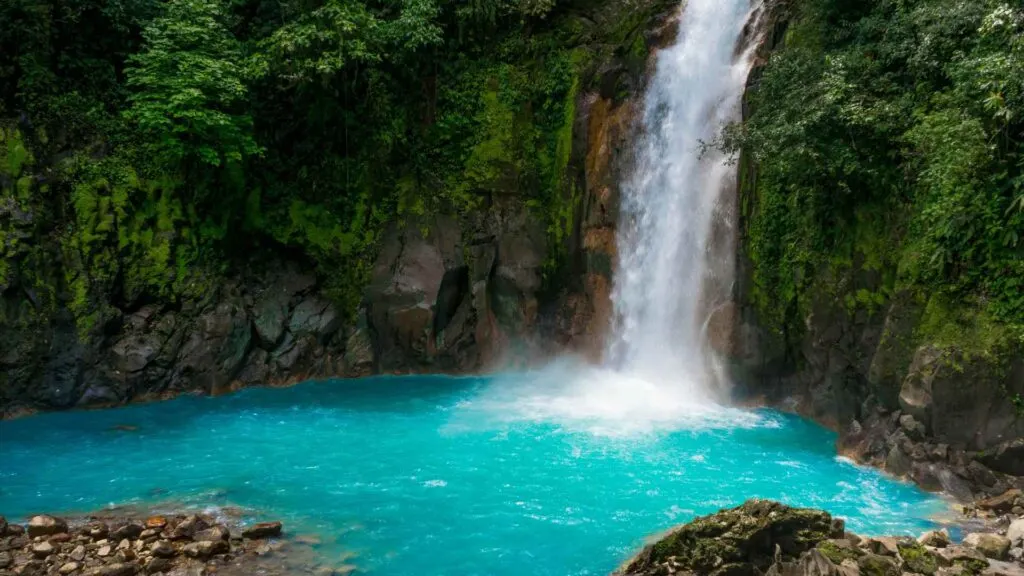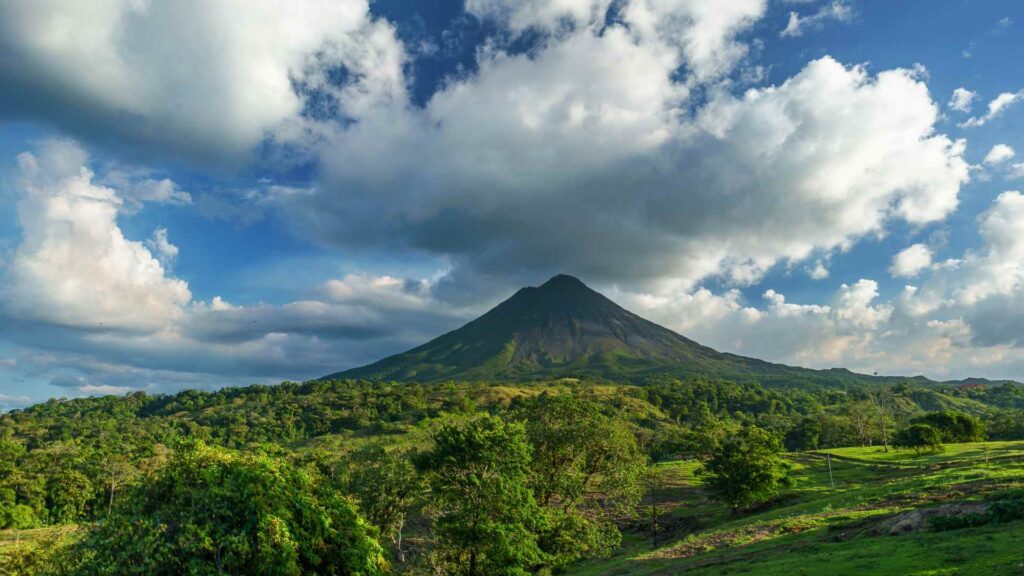Costa Rica is a gem of biodiversity, adventure, and rich culture. From pristine beaches to active volcanoes, it’s a land full of surprises.
Discover fascinating fun facts about Costa Rica, its wildlife, people, and unique quirks in this comprehensive guide. Whether you’re planning a trip or just curious, this list has it all!
Nature and Landscape
- Costa Rica is home to over 5% of the world’s biodiversity.
- There are 28 national parks across the country, offering protection to its diverse habitats.
- The Arenal Volcano, one of Costa Rica’s most famous, was active for over 40 years.
- Costa Rica has a cloud forest ecosystem, with Monteverde Cloud Forest being the most famous.
- Over 25% of Costa Rican land is protected by law to conserve wildlife and forests.
- The Río Celeste river is renowned for its unique turquoise color, caused by volcanic minerals.
- Costa Rica borders both the Pacific Ocean and the Caribbean Sea.
- Costa Rica’s dry season runs from December to April, ideal for beach-goers.
- The country experiences over 100 different microclimates.
- Costa Rica has its own “mini desert” area, known as the Guanacaste region.
- Lake Arenal is the largest lake in Costa Rica and was artificially expanded for hydroelectric power.
- The Osa Peninsula is one of the most biologically intense places on Earth.
- Costa Rica has more than 200 volcanic formations, with six active volcanoes.
- The Nicoya Peninsula is one of the world’s five Blue Zones, known for longevity.
- Rainforests cover approximately 51% of Costa Rica’s territory.

Costa Rican Culture
- Costa Rica’s motto, “Pura Vida,” means “pure life” and reflects the country’s easy-going attitude.
- Soccer, known locally as “fútbol,” is the most popular sport.
- The traditional folk dance of Costa Rica is called “El Punto Guanacasteco.”
- Costa Rica has no standing army since 1949 and celebrates this with “Día de la Abolición del Ejército.”
- “Ticos” and “Ticas” are affectionate terms for Costa Rican men and women.
- Family values are incredibly important in Costa Rican society.
- National dress includes vibrant colors, representing the country’s cheerful spirit.
- Costa Rican slang includes unique words like “mae,” similar to “dude.”
- Bullfighting exists in Costa Rica, but it’s a non-lethal form called “Corrida de Toros.”
- Christmas is one of the most important holidays in Costa Rica.
- Costa Ricans celebrate a week-long festival in July called “Fiestas de los Diablitos.”
- Rural Costa Ricans often use ox carts, which are also an iconic symbol of Costa Rican culture.
- Costa Rica celebrates the arrival of the Spanish with “Día de San Juan.”
- Costa Rican schools teach students a song called the “Himno Nacional.”
- Costa Ricans observe “El Día de la Raza,” celebrating indigenous heritage.

Unique Wildlife
- Costa Rica hosts over 500,000 species, including exotic animals, insects, and plants.
- Sloths, both two-toed and three-toed, are common in Costa Rican rainforests.
- The Resplendent Quetzal, a rare and colorful bird, resides in Costa Rica.
- Costa Rica is one of the best places to spot Scarlet Macaws in the wild.
- The country is known for its stunningly diverse frog species, including the Red-Eyed Tree Frog.
- Jaguars roam the Costa Rican rainforests, though they are very elusive.
- Butterflies are abundant; Costa Rica has about 10% of the world’s butterfly species.
- Sea turtles, like the Olive Ridley, nest along Costa Rica’s beaches.
- The capuchin monkey, with its distinct white face, is common in many forests.
- Costa Rica is home to the poisonous dart frog, which has bright coloring.
- The country has a large population of leaf-cutter ants, a vital part of the ecosystem.
- Crocodiles thrive along the Tarcoles River, where you can see them up close.
- Hummingbirds are plentiful, with more than 50 species found across the country.
- Coatis, raccoon-like animals, are seen in many parts of Costa Rica.
- Whales migrate to Costa Rican waters between July and November.
Costa Rica’s History
- Costa Rica gained independence from Spain on September 15, 1821.
- The country was briefly part of the Mexican Empire after independence.
- Coffee production helped shape the country’s economy and history.
- Costa Rica abolished its military in 1949, redirecting funds to education and healthcare.
- The national currency, the colón, was named after Christopher Columbus.
- San José, Costa Rica’s capital, was one of the first cities in Latin America with electricity.
- Costa Rica joined the United Nations in 1945.
- Costa Rica is part of the Central American Integration System (SICA).
- The National Theater, built in 1897, represents Costa Rica’s cultural pride.
- The civil war of 1948 was the last in Costa Rica’s history.
- Former President Oscar Arias won the Nobel Peace Prize in 1987.
- Costa Rica’s first railway connected the capital to the Caribbean port of Limón.
- The country was a founding member of the Organization of American States.
- Indigenous tribes, like the Bribri and Boruca, contribute to Costa Rica’s cultural heritage.
- Costa Rica celebrates Independence Day with parades and traditional music.

Economy and Agriculture
- Coffee is known as Costa Rica’s “Golden Bean” and was once the main export.
- Costa Rica is one of the world’s largest producers of bananas.
- Tourism is now the largest source of income for the country.
- Costa Rican coffee is considered some of the best in the world.
- Pineapple plantations thrive in the tropical lowlands.
- Costa Rica is known for producing fine chocolate, made from local cacao.
- Eco-tourism plays a significant role in the economy.
- Rice and beans are staple crops for local consumption.
- The country’s economy is heavily invested in sustainable farming.
- Intel has a strong manufacturing presence in Costa Rica.
- Dairy farming, especially in the Central Valley, contributes to the food industry.
- Costa Rica exports ornamental plants to global markets.
- The fishing industry primarily focuses on tuna and mahi-mahi.
- Costa Rica imports more than it exports in electronics and fuel.
- Many Costa Ricans work in the technology sector as engineers and developers.
Bonus Fun Facts
- Costa Rica’s official language is Spanish, but English is widely understood.
- Costa Rica’s nickname, “Rich Coast,” comes from Spanish explorers.
- Many Costa Ricans believe in “duendes,” mythical creatures of folklore.
- National parks in Costa Rica can be explored by zip-lining.
- You’ll find many “sodas,” local eateries with traditional Costa Rican food.
- Costa Rica has a lower crime rate than most Latin American countries.
- The traditional cartwheel symbol is protected by UNESCO.
- Costa Rica has no nuclear power plants.
- Many Costa Ricans retire in coastal towns along the Pacific.
- Pura Vida is used as a greeting, goodbye, and expression of joy.
- Costa Rica practices universal healthcare.
- Costa Rica is the only country to meet all its electricity needs from renewable energy.
- Red taxis with meters are common throughout the country.
- The currency, colones, often features Costa Rican wildlife on the bills.
- The Tabacón hot springs are heated naturally by Arenal Volcano.
- Costa Rica is famous for river rafting adventures.
- The tallest mountain, Cerro Chirripó, stands at 12,533 feet.
- Costa Rica has over 800 miles of coastline.
- Bullfighting in Costa Rica doesn’t harm the bulls.
- Costa Ricans celebrate La Negrita, or the Virgin of Los Angeles.
- “Carretas” or traditional oxcarts, are painted in bright colors.
- Costa Rica’s literacy rate is 97%.
- Its rainforests are some of the oldest in the world.
- Costa Rica offers free basic education to all citizens.
- San José is home to a large collection of pre-Columbian gold.
- Many Costa Ricans enjoy visiting the Central Market for fresh produce.
- The country has a Women’s World Cup team for soccer.
- Costa Rica’s Pacific beaches are a haven for surfers.
